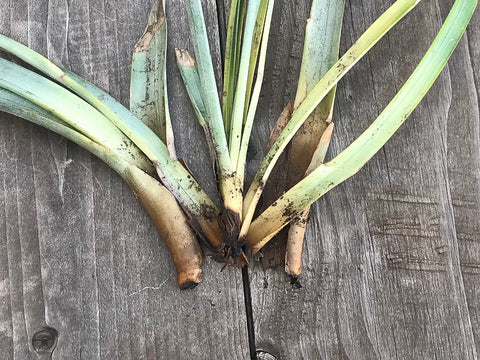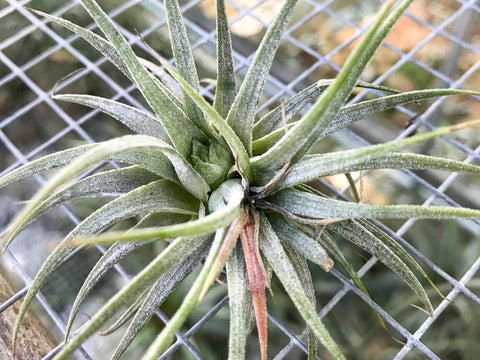Just a few days ago your air plant seemed fine. You watered it just like you normally do, and now a few days later, it’s completely falling apart! What is happening? Sorry to say, but your little air plant may be the victim of wet rot. Maybe you left your plants in their bath a little too long, or you forgot to shake out the excess water from the leaves before putting it back in its place. Whatever it was, somehow water sat amongst the leaves and base of your plant which caused it to rot. Your air plant can also suffer from what is referred to as dry rot, which is caused when there is lack of airflow and the plant suffers. Most of the time rot is caused by over watering and staying wet/damp for prolonged periods of time allowing fungus and bad bacteria to take hold and damage the plant.
Identifying Rot
If the base of your air plant looks brown and feels overly soft/mushy to the touch, it might be the victim of rot or fungus. Often times a rotting air plant will also lose leaves around its base and could start to fall apart, or the center of the air plant might come out. Inner rot is tough to diagnose as you generally are not aware until the plant just falls apart one day, normally from the inside leaves first.
Signs of inner rot/fungus on a Tillandsia
The start of leaf rot on a tillandsia ionantha
Note that some air plants like the melanocrater tricolor will have naturally darker bases. Also some leaf shedding can be normal in healthy air plants.
Leaf rot and fungal issues can also been seen on the outer leaves, which is much more noticeable than inner rot. You may notice this as dark spots on the base of the plant, which will continue to spread over time. In this scenario, in an attempt to save the plant it's best to try to remove the affected leaves from the base of the plant to stop the spread of the fungus/rot.
In the pictures below, we show a T. stricta that is showing some signs of leaf damage and possible fungal issue. While it's normal for some leaves at the base of an air plant (Tillandsia) to become dry or brown and die off, there is a dark circular area of the leaf that doesn't look normal. In this case, we gently removed some of the leaves at the base of the plant to help prevent any spread of possible fungus. The photo on the right shows the plant after cleaning up with the affected leaves removed. It's ok if the very tip of the base has some browning or looks callused over, as this is the bottom of the stem where roots will grow form.
How to avoid rot
There are some simple ways to avoid rot:
- Stick to a watering schedule and make sure not to over water. Remember that Tillandsia are different from many common house plants in that they take in moisture through their leaves and trichomes, not their roots, and can be susceptible to over-watering.
- Never leave an air plant submerged in water for long periods of time.
-
Tailor your care and watering schedule to the type of Tillandsia (air plant) you have. Silver leafed varieties are considered Xeric, and will need different levels of water (and even different watering methods) than Mesic green-leafed varieties. To learn more about the different types of air plants, check out this article about Xeric and Mesic air plants. For general care info check out our article all about Air Plant Care.
- After watering, make sure to shake out any excess water from your air plant, and let the plant dry completely before adding it back to your terrarium, shell, or wherever you have your plant displayed. Do not spray air plants in their terrariums or allow them to sit against moisture.
- Pay particularly close attention to bulbous air plants as well as air plants which have deep pockets in their leaf base, as these can be more prone to holding water in their base.
- Air flow is important! Don’t display your air plant in a closed off terrarium or container. If your terrarium has a lid, leave it off. Air plants need proper air circulation to thrive, and without this, rot can occur.
- Remove any exterior leaves at the base if they are showing signs of fungus or rot starting. If the plant has inner rot, trying to remove the inner leaves will not work and will likely be damaging to the plant.
My Air Plant Is Rotting. Can it be saved?
Unfortunately, rot tends to be one of the things that, once it starts, is hard to reverse and save the plant from. The best remedy for rot is prevention! Having said that, cinnamon has been known to help reduce or stop rot/fungus on the base of plants as its a natural fungicide and may be worth a try! If only a few outer leaves are affected, we also recommend removing those leaves as previously depicted.




























Great article. I can’t believe a lost a beautiful xerographica to rot the other day. I noticed clumps of off color pieces of a sticky gel like substance too
I tried cleaning it out but it didn’t help. This happened to a different plant that was bulbous with pockets. They were more round balls…could they be eggs too?
If one airplane has rot when soaking all in water it will pass the rot spores to all the others. It happened to me. I lost 35 plants in the next few months.
No community bathes now, they get sprayed well every day, gently shaken and put back on the wall. Lost my Tectorum to spring water, it died mineral
encrusted. I inspect every plant every day looking for Rot.
Thank you for informing me on taking care of my air plants. I am new at this and need all of the help that I can get.
Can u explain the method and frequency whereby cinnamon can be applied to the plant.
Thanks for the info! Love your site and your plants!
Leave a comment